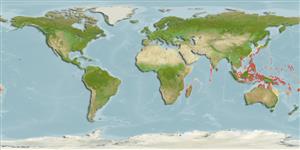分類 / Names
俗名 | 同種異名 | Catalog of Fishes(屬, 種) | ITIS | CoL | WoRMS | Cloffa
Teleostei >
Gobiiformes (Gobies)
鱸形目 (Gobies) >
Gobiidae (Gobies)
鰕虎魚科 (Gobies) > Gobiinae
Etymology: Cryptocentrus: Greek, kryptos = hidden + Greek, kentron = sting (Ref. 45335).
More on author: Regan.
Environment: milieu / climate zone / depth range / distribution range
生態學
海洋 居於水底的; 深度上下限 0 - 4 m (Ref. 1602). 熱帶
Indo-West Pacific: East Africa to the Mariana Islands, north to southern Japan; Belau, Ifaluk, and Guam in Micronesia.
印度-西太平洋: 東非到馬里亞納群島, 北至日本南部; 在密克羅尼西亞的帛琉,伊法盧克與關島。
大小 / 重量 / 年齡
Maturity: Lm ? range ? - ? cm
Max length : 4.5 cm SL 雄魚/尚未辨別雌雄; (Ref. 1602)
簡短描述
檢索表 | 型態特徵 | 形態測量圖
背棘 (總數) : 7; 背的軟條 (總數) : 10; 臀棘: 1; 臀鰭軟條: 9. Resembles C. koumansi, but differs by having numerous small iridescent blue spots over a dark background with at least 8 transverse bars and 3 to 4 dark round spots longitudinally along the sides.
與 C. koumansi 相似, 但是不同之處為用至少有在深色的背景上的很多小藍色虹彩的斑點 8條橫跨的橫帶與 3 到 4個深色的圓斑點縱向地沿著側邊。
Common in fine sand or silt bottoms of shallow lagoons and coastal bays subject to terrestrial runoff at depths of 0.3 to 4 m. Uses the burrow of an alpheid species.
常見於細砂或潟湖淺灘與近岸海灣的淤泥底受陸地來的流水深度 0.3 到 4 公尺支配。 使用槍蝦種的洞穴。
Life cycle and mating behavior
Maturities | 繁殖 | Spawnings | Egg(s) | Fecundities | 仔魚
印度-西太平洋: 東非到馬里亞納群島, 北至日本南部; 在密克羅尼西亞的帛琉,伊法盧克與關島。
Myers, R.F., 1991. Micronesian reef fishes. Second Ed. Coral Graphics, Barrigada, Guam. 298 p. (Ref. 1602)
人類使用
工具
特別的報告
下載 XML
網路資源
Estimates based on models
Preferred temperature (Ref.
123201): 25.4 - 29.3, mean 28.6 °C (based on 1810 cells).
Phylogenetic diversity index (Ref.
82804): PD
50 = 0.5000 [Uniqueness, from 0.5 = low to 2.0 = high].
Bayesian length-weight: a=0.01023 (0.00477 - 0.02194), b=3.02 (2.84 - 3.20), in cm total length, based on LWR estimates for this (Sub)family-body shape (Ref.
93245).
營養階層 (Ref.
69278): 3.2 ±0.3 se; based on size and trophs of closest relatives
回復力 (Ref.
120179): 高度, 族群倍增時間少於 15個月 (Preliminary K or Fecundity.).
Fishing Vulnerability (Ref.
59153): Low vulnerability (10 of 100).
